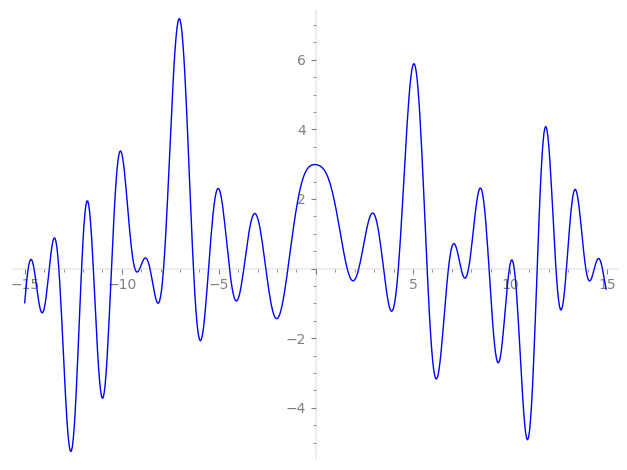| L(s) = 1 | + (2.21 + 1.28i)3-s + (0.946 − 2.02i)5-s + (1.73 + 2i)7-s + (1.78 + 3.08i)9-s + (3.26 − 5.65i)11-s + 2.86i·13-s + (4.69 − 3.28i)15-s + (3.17 + 1.83i)17-s + (−3.26 − 5.65i)19-s + (1.28 + 6.65i)21-s + (−3.57 + 2.06i)23-s + (−3.20 − 3.83i)25-s + 1.43i·27-s − 4·29-s + (−1.83 + 3.17i)31-s + ⋯ |
| L(s) = 1 | + (1.28 + 0.739i)3-s + (0.423 − 0.905i)5-s + (0.654 + 0.755i)7-s + (0.593 + 1.02i)9-s + (0.984 − 1.70i)11-s + 0.793i·13-s + (1.21 − 0.847i)15-s + (0.769 + 0.444i)17-s + (−0.748 − 1.29i)19-s + (0.279 + 1.45i)21-s + (−0.744 + 0.429i)23-s + (−0.641 − 0.767i)25-s + 0.276i·27-s − 0.742·29-s + (−0.329 + 0.570i)31-s + ⋯ |
\[\begin{aligned}\Lambda(s)=\mathstrut & 1120 ^{s/2} \, \Gamma_{\C}(s) \, L(s)\cr =\mathstrut & (0.977 - 0.211i)\, \overline{\Lambda}(2-s) \end{aligned}\]
\[\begin{aligned}\Lambda(s)=\mathstrut & 1120 ^{s/2} \, \Gamma_{\C}(s+1/2) \, L(s)\cr =\mathstrut & (0.977 - 0.211i)\, \overline{\Lambda}(1-s) \end{aligned}\]
Particular Values
| \(L(1)\) |
\(\approx\) |
\(2.987668906\) |
| \(L(\frac12)\) |
\(\approx\) |
\(2.987668906\) |
| \(L(\frac{3}{2})\) |
|
not available |
| \(L(1)\) |
|
not available |
\(L(s) = \displaystyle \prod_{p} F_p(p^{-s})^{-1} \)
| $p$ | $F_p(T)$ |
|---|
| bad | 2 | \( 1 \) |
| 5 | \( 1 + (-0.946 + 2.02i)T \) |
| 7 | \( 1 + (-1.73 - 2i)T \) |
| good | 3 | \( 1 + (-2.21 - 1.28i)T + (1.5 + 2.59i)T^{2} \) |
| 11 | \( 1 + (-3.26 + 5.65i)T + (-5.5 - 9.52i)T^{2} \) |
| 13 | \( 1 - 2.86iT - 13T^{2} \) |
| 17 | \( 1 + (-3.17 - 1.83i)T + (8.5 + 14.7i)T^{2} \) |
| 19 | \( 1 + (3.26 + 5.65i)T + (-9.5 + 16.4i)T^{2} \) |
| 23 | \( 1 + (3.57 - 2.06i)T + (11.5 - 19.9i)T^{2} \) |
| 29 | \( 1 + 4T + 29T^{2} \) |
| 31 | \( 1 + (1.83 - 3.17i)T + (-15.5 - 26.8i)T^{2} \) |
| 37 | \( 1 + (-0.695 + 0.401i)T + (18.5 - 32.0i)T^{2} \) |
| 41 | \( 1 - 1.56T + 41T^{2} \) |
| 43 | \( 1 - 8.24iT - 43T^{2} \) |
| 47 | \( 1 + (-3.57 + 2.06i)T + (23.5 - 40.7i)T^{2} \) |
| 53 | \( 1 + (-0.695 - 0.401i)T + (26.5 + 45.8i)T^{2} \) |
| 59 | \( 1 + (1.02 - 1.78i)T + (-29.5 - 51.0i)T^{2} \) |
| 61 | \( 1 + (-4.84 - 8.38i)T + (-30.5 + 52.8i)T^{2} \) |
| 67 | \( 1 + (3.95 + 2.28i)T + (33.5 + 58.0i)T^{2} \) |
| 71 | \( 1 + 5.72T + 71T^{2} \) |
| 73 | \( 1 + (8.13 + 4.69i)T + (36.5 + 63.2i)T^{2} \) |
| 79 | \( 1 + (1.83 + 3.17i)T + (-39.5 + 68.4i)T^{2} \) |
| 83 | \( 1 - 0.246iT - 83T^{2} \) |
| 89 | \( 1 + (-6.84 - 11.8i)T + (-44.5 + 77.0i)T^{2} \) |
| 97 | \( 1 - 18.7iT - 97T^{2} \) |
| show more | |
| show less | |
\(L(s) = \displaystyle\prod_p \ \prod_{j=1}^{2} (1 - \alpha_{j,p}\, p^{-s})^{-1}\)
Imaginary part of the first few zeros on the critical line
−9.326299776806612218136826699568, −9.072549882555976028522233707561, −8.547285855862963344539059302334, −7.84774670690223532243270931088, −6.30722715701138731402056630724, −5.52855335225141802646439040638, −4.45075214642651420709520414723, −3.71320336020537760737244515000, −2.57938161335895602326850201175, −1.44183811041855788038249279015,
1.61204821292400320678490386824, 2.20984586785649966844126826484, 3.48415203113116971072046379561, 4.24447586929055389788678157277, 5.72917590582598443126563177872, 6.82610126806680644253539079159, 7.47660854867883730600797337710, 7.86151598528471964500348398330, 8.917871071955311590902634624867, 9.963322479254411270488391576776

